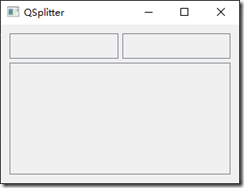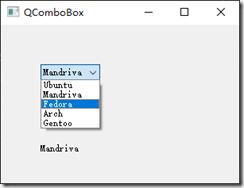【第八节】PyQt5控件(II)
在这里我们将继续介绍PyQt5控件。我们将介绍QPixmap、QLineEdit QSplitter,QComboBox。
QPixmap
QPixmap是用于处理图像的控件。是优化的显示图像在屏幕上。在我们的代码示例中,我们将使用QPixmap窗口显示一个图像。
# -*- coding: utf-8 -*-
"""
PyQt5 tutorial
In this example, we dispay an image
on the window.
author: py40.com
last edited: 2017年3月
"""
import sys
from PyQt5.QtWidgets import (QWidget, QHBoxLayout,
QLabel, QApplication)
from PyQt5.QtGui import QPixmap
class Example(QWidget):
def __init__(self):
super().__init__()
self.initUI()
def initUI(self):
hbox = QHBoxLayout(self)
pixmap = QPixmap("icon.png")
lbl = QLabel(self)
lbl.setPixmap(pixmap)
hbox.addWidget(lbl)
self.setLayout(hbox)
self.move(300, 200)
self.setWindowTitle('Red Rock')
self.show()
if __name__ == '__main__':
app = QApplication(sys.argv)
ex = Example()
sys.exit(app.exec_())在窗口上显示一个图片
pixmap = QPixmap("icon.png")创建一个QPixmap 对象,它将传入的文件名作为参数。
lbl = QLabel(self) lbl.setPixmap(pixmap)
我们将这个pixmap放到QLabel控件中。
文本框 QLineEdit
QLineEdit是用于输入或编辑单行文本的控件。它还有撤销重做、剪切复制和拖拽功能。
# -*- coding: utf-8 -*-
"""
PyQt5 tutorial
This example shows text which
is entered in a QLineEdit
in a QLabel widget.
author: py40.com
last edited: 2017年3月
"""
import sys
from PyQt5.QtWidgets import (QWidget, QLabel,
QLineEdit, QApplication)
class Example(QWidget):
def __init__(self):
super().__init__()
self.initUI()
def initUI(self):
self.lbl = QLabel(self)
qle = QLineEdit(self)
qle.move(60, 100)
self.lbl.move(60, 40)
qle.textChanged[str].connect(self.onChanged)
self.setGeometry(300, 300, 280, 170)
self.setWindowTitle('QLineEdit')
self.show()
def onChanged(self, text):
self.lbl.setText(text)
self.lbl.adjustSize()
if __name__ == '__main__':
app = QApplication(sys.argv)
ex = Example()
sys.exit(app.exec_())示例中展示了一个QLineEdit与一个QLabel。我们在QLineEdit中输入的文字会实时显示在QLabel控件中。
qle = QLineEdit(self)
创建QLineEdit
qle.textChanged[str].connect(self.onChanged)
文本框的内容发生改变的时候,会调用onChanged方法
def onChanged(self, text):
self.lbl.setText(text)
self.lbl.adjustSize() 在onChanged()方法中我们将QLabel控件的文本设置为输入的内容。通过调用adjustSize()方法将QLabel控件的尺寸调整为文本的长度
QSplitter
通过QSplitter,用户可以拖动子控件边界来调整子控件的尺寸。在下面的示例中,我们展示了三个由两个QSplitter组织的QFrame控件。
# -*- coding: utf-8 -*-
"""
PyQt5 tutorial
This example shows
how to use QSplitter widget.
author: py40.com
last edited: 2017年3月
"""
import sys
from PyQt5.QtWidgets import (QWidget, QHBoxLayout, QFrame,
QSplitter, QStyleFactory, QApplication)
from PyQt5.QtCore import Qt
class Example(QWidget):
def __init__(self):
super().__init__()
self.initUI()
def initUI(self):
hbox = QHBoxLayout(self)
topleft = QFrame(self)
topleft.setFrameShape(QFrame.StyledPanel)
topright = QFrame(self)
topright.setFrameShape(QFrame.StyledPanel)
bottom = QFrame(self)
bottom.setFrameShape(QFrame.StyledPanel)
splitter1 = QSplitter(Qt.Horizontal)
splitter1.addWidget(topleft)
splitter1.addWidget(topright)
splitter2 = QSplitter(Qt.Vertical)
splitter2.addWidget(splitter1)
splitter2.addWidget(bottom)
hbox.addWidget(splitter2)
self.setLayout(hbox)
self.setGeometry(300, 300, 300, 200)
self.setWindowTitle('QSplitter')
self.show()
def onChanged(self, text):
self.lbl.setText(text)
self.lbl.adjustSize()
if __name__ == '__main__':
app = QApplication(sys.argv)
ex = Example()
sys.exit(app.exec_())示例中我们创建了三个QFrame与两个QSplitter。注意在某些主题中这些QSplitter可能会不可见。topleft = QFrame(self) topleft.setFrameShape(QFrame.StyledPanel)
我们使用一个风格框架为了看到QFrame小部件之间的界限。
splitter1 = QSplitter(Qt.Horizontal) splitter1.addWidget(topleft) splitter1.addWidget(topright)
我们创建一个QSplitter小部件和添加两个帧。
splitter2 = QSplitter(Qt.Vertical) splitter2.addWidget(splitter1)
我们也可以将QSplitter添加到另一个QSplitter控件中。
下拉列表 QComboBox
QComboBox是允许用户从下拉列表中进行选择的控件。
# -*- coding: utf-8 -*-
"""
PyQt5 tutorial
This example shows how to use
a QComboBox widget.
author: py40.com
last edited: 2017年3月
"""
import sys
from PyQt5.QtWidgets import (QWidget, QLabel,
QComboBox, QApplication)
class Example(QWidget):
def __init__(self):
super().__init__()
self.initUI()
def initUI(self):
self.lbl = QLabel("Ubuntu", self)
combo = QComboBox(self)
combo.addItem("Ubuntu")
combo.addItem("Mandriva")
combo.addItem("Fedora")
combo.addItem("Arch")
combo.addItem("Gentoo")
combo.move(50, 50)
self.lbl.move(50, 150)
combo.activated[str].connect(self.onActivated)
self.setGeometry(300, 300, 300, 200)
self.setWindowTitle('QComboBox')
self.show()
def onActivated(self, text):
self.lbl.setText(text)
self.lbl.adjustSize()
if __name__ == '__main__':
app = QApplication(sys.argv)
ex = Example()
sys.exit(app.exec_())示例中展示了一个QComboBox与一个QLabel,QComboBox控件中有5个选项(Linux系统的几个发行版名称)。QLabel控件会显示QComboBox中选中的某个选项。
combo = QComboBox(self)
combo.addItem("Ubuntu")
combo.addItem("Mandriva")
combo.addItem("Fedora")
combo.addItem("Arch")
combo.addItem("Gentoo")创建了一个有五个选项的QComboBox
combo.activated[str].connect(self.onActivated)
当选中某个条目时会调用onActivated()方法
def onActivated(self, text):
self.lbl.setText(text)
self.lbl.adjustSize() 在方法中我们将QLabel控件的内容设置为选中的条目,然后调整它的尺寸。






 浙公网安备 33010602011771号
浙公网安备 33010602011771号